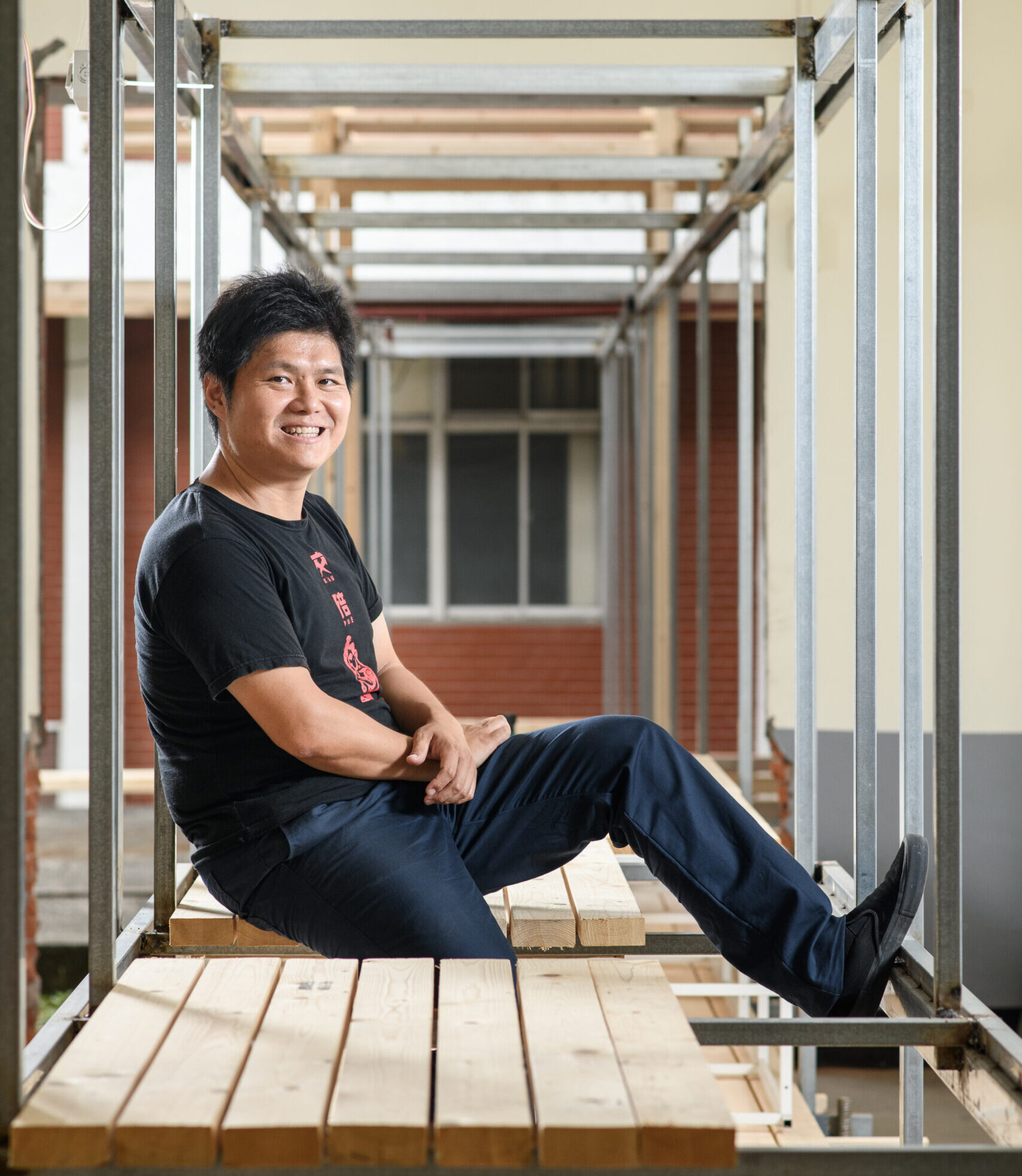由建築師陳宣誠所主持的「負育群帶聚落」,自2017年起進駐臺灣當代文化實驗場,進行包含國際講座、工作坊、表演、現場實作討論等活動的實驗建築計畫。實驗場的前身為空軍總部,地理位置居於資源豐富的市中心,內部多為低矮房舍或操練場,團隊名稱的「負」即意指這些戶外且開發密度偏低的「負空間」,「育」則以教育為核心,思考實驗場之於建築的新可能性,形成一個關係性強的生產聚落。跨出傳統建築疆界,其成員除了建築師、藝術與地景相關知識的策展人以外,還包括記錄空間聲音、植物生態、文史故事等訊息的「採集研究團隊」,從中探討建築與實踐的想像,試圖將問題意識擴展到整個臺北盆地,乃至於和整個臺灣的關係。
「在當代思考建築,以往似乎都掌握在知識分子身上,必須擁有一定的技術知識才能進行。」改變環境之餘,對陳宣誠而言,詮釋當代文化其實是一個「如何參與」的問題。「當代文化應該是一種邀請人們來工作的狀態。它是一個自覺,讓大家意識到這是他們應該、也可以關心的事情,藉此達成資源轉化,實際創造生產。」每個個體都應從關心自身的生活周遭開始,進而擁有學習能力、掌握知識與技術、理解建築與環境。舉例而言,當團隊討論都市農場的可行性與形式時,不同領域的調查研究者、專家和藝術家便開始集思廣益,最後可能與一位植物醫生合作,把城市裡蒐集來的廢棄物變成一個植物培養皿。團隊為什麼要做一些建築之外的事情,正是要讓人們能夠藉由參與來形成自理,有意識地去做選擇。
團隊的工作狀態對陳宣誠而言,並非只是集合大家在一個容器內從事建築工作,而是一段彼此碰撞出火花、不斷構築新起點的網帶過程;當構想在逐步討論與實作中漸漸成形,那種依循各自專業去掌握未知的工作方式,十分令人著迷。

「是否有一種開放性或者修補性的建構方式,不是封閉地加諸自己的美學想法,而是試圖把人與環境之間的關係修補在一起?」陳宣誠因自身所受的建築教育,加上曾在高端建設公司的工作經驗,認為當代建築的應用系統常處於封閉狀態。設計者自給自足地形成一套美學系統,轉接給使用者後續發揮,雖然連結度與市場流動性很高,網絡卻終究是閉合的,此時創作者的考慮就傾向於一種營運策略,例如要怎麼在A地段去操作B商品,本質上是經濟模式的運轉。這樣的納悶長期困擾著陳宣誠,直到有一次,他來到嘉義鄉下的一間柑仔店,發現屋齡將近百年的老房子裡,牆壁上有個缺了幾塊磚頭的缺口。照一般的建築訓練來說,此時該做的就是予以補齊或者重新翻修,使之能有更好的使用狀態。然而,已屆耄耋之年的老奶奶屋主只是在缺口擺上盆栽,又因為怕植物曬太多太陽,加裝了蘭花網把它們圍起來,整面牆看上去像是補好了一樣。老奶奶就這麼每天去牆邊澆水,社區經過的人也會在那裡跟她聊天、打招呼,生活並未因破損的牆面受到影響,甚至還變得更加豐富。這次經驗帶給他非常大的啟發,也成為他個人的設計理念。
當創作者抵達現場,以建築師或者不同領域的主體身分從環境中「採集」出不同的東西,足以形成一種特殊的空間範圍和場域關係;這之後才是關於「修補」。然而來自各方的專業該如何合作,又有哪些關係連在一起可以有所發揮?上述兩點結合,便是陳宣誠身為一位建築創作者,念茲在茲的「在場」。
現在,陳宣誠對於事物的開放性更感興趣,專注在建築的既有模式上創新,同時追尋自身的理念目標。已是展覽常客的他,過去對展覽的認識與建築類似,都是屬於在某處停滯的封閉系統,後來卻逐漸感受到兩者的功能,認為它們可以改變一個地方,或者修補一些關係。這也關連到陳宣誠近幾年在中原大學帶領學生的教學經驗,課程內容包含舊房舍的實地考察與改建,但他認為最重要的還是學生的感知能力:在現場看到了什麼?聽到了什麼?「採集」了什麼?如何認識他所處的環境?這樣的觀察方法是建築設計的重要觀念,不僅止於空間幾何或造型關係,而是反向審視內在,透過現場去認識自己,才會有重新學習跟往前進展的能力。
 團隊的工作狀態對陳宣誠而言,並非只是集合大家在一個容器內從事建築工作,而是一段彼此碰撞出火花、不斷構築新起點的網帶過程。圖/王世邦攝影
團隊的工作狀態對陳宣誠而言,並非只是集合大家在一個容器內從事建築工作,而是一段彼此碰撞出火花、不斷構築新起點的網帶過程。圖/王世邦攝影
2015年,由陳宣誠所引領的團隊「共感地景創作」(ArchiBlur Lab)成立,不僅從事建築的實驗、設計與發明,也重視教育、策展和社區調查研究。團隊主張將建築作為一種探勘臺灣空間的觀察工具,以創作探索身體與地景之間的共感關係,尤以2016年獲獎無數的「城市浮洲」系列為其代表作。
「處理一個空間的時候,創作者該如何讓過去、現在和未來的使用者與空間產生互動,將本來缺乏連結、情感、色彩、溫度與質感的封閉所在,轉化為可感受且吸引人的空間安排,看見『原本看不到的地方』,這一點非常迷人。」陳宣誠解釋,藉由拓展建築的公共性,針對不同使用者的需求做出變化,核心概念回到源頭,其實是在研究人。例如團隊2017年接了一個幼兒園的案子,花了很多力氣研究特定的小朋友如何在空間裡活動,再以此進行設計發想,「不是要做一個東西把人放進去,而是讓人能夠透過這個東西,把本來在做的事情用不同的規模和尺度去進行。」
不過,由於建築涉及的資本實在太大,要如何相信一個對象與其方法,比起立即性的成果更加重視過程,這一點非常困難。「實踐很重要,但也有必要回來說明它。」陳宣誠在讀博士的時候,對於自己在做的事需要不斷地說明、從每次的實踐裡找出可以被論述的部分,這個訓練「不只用來傳遞理念,更要深入反省:我有沒有做到?我還能再做什麼?」人們常引用一些國際大師作為案例,卻往往只看到表面形式,忽略他們與自身文化的深厚連結,其實這些根基都是經過長時間的成長才有辦法穩固。因此陳宣誠認為,臺灣的建築環境唯有透過不斷地實踐與論述,才會越來越好。
建築工作者的心中常有一個大的願景,想蓋一棟101或者雙子星大樓,但陳宣誠反而想去規劃Ubike。他之所以感興趣,是因Ubike系統可以成為一個與所有事物相關的網路,包括先前主導的「城市浮洲」計畫也是想朝這個方向走。這好比一個新的五金構件如果可以進入更大的系統,被運用到更多層面,或許就能夠發揮由小見大的影響力。但這樣的理念在臺灣的建築體系卻難以實現,現行設計教育環境的難處是,建築與建築教育都是傳統產業,很難進入到新的向度,而學校為了取得更好的資源,只得變得更加封閉,學生不用管公共事務,只要把自己的事情做好就好。有沒有可能在教育學習階段就讓學生與社會接軌,從實務層面來扭轉這個部分?如何以實踐的方式回過頭來改造社會,同時保持微觀生活的空間美學、尊重土地與生命、構築臺灣空間的新想像,這是陳宣誠與「共感地景創作」未來的願景之一。